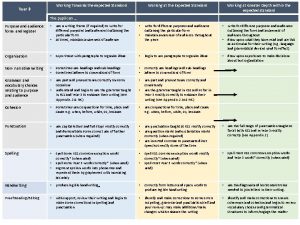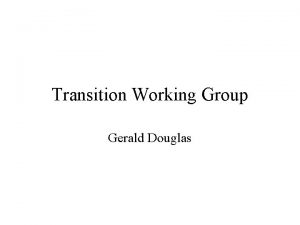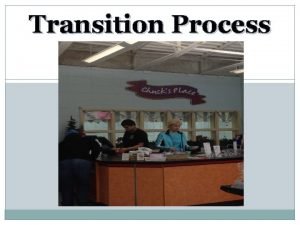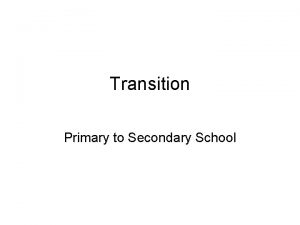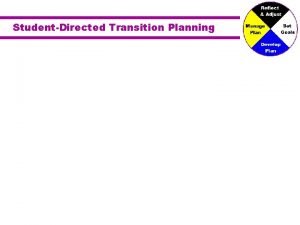JUST TRANSITION WORKING GROUP Vision towards a Just





- Slides: 5

JUST TRANSITION WORKING GROUP Vision towards a Just Transition JULY 2020 NATIONAL OFFICE PARLIAMENTARY OFFICE 61 Katherine Street, 9 Church Square, 1 st Floor Graaffs Sandton, 2196 Trust Building P. O. Box 652807, Cape Town, CBD Benmore, 2010 P. O. Box 3867, Cape Town, 8000

WHAT IS THE PURPOSE OF SETTING A VISION As presented at the Visioning Workshop, a Vision: • should be audacious but achievable. • must be relevant, authentic, and credible. • should reach beyond current capabilities and will require innovation, risk • taking, and change. • imagines a different world for the future, rather than an ambition rooted in today’s context or business constraints. A Vision is a “north star”; a guide for future work – in this case the pathways towards a Just Transition. This Vision is not a target or a goal. The Vision helps understand the implications of the change required and the pathways to achieve this. This includes the risks and opportunities presented by the transition. A Vision helps contextualise what we can do as a country, and what more we could do with financial, technological and other aid (as per our NDC).

HIGH-LEVEL VISION 2050 People: • SA's inclusive economy leaves no one behind • South African's people are empowered: South Africans are more resilient (less vulnerable) to catastrophes (environmental, economic, health) through excellence in education, and a thriving green, carbon neutral economy which enables entrepreneurship and innovation Economic: Leading the region with a carbon neutral, sustainable economy that matches and even exceeds the NDP economic growth ambition and supports the eradication of the triple challenges of poverty, unemployment and inequality Environmental/Climate: • SA has reached carbon neutrality and created a resilient society and ecologically sustainable economy through maintaining resilient ecosystems and healthier, economically active communities

CARBON NEUTRAL & NET ZERO VS ZERO CARBON As defined in the NPC’s 2050 Vision and Pathways for a Just Transition to a low carbon, climate resilient economy and society document (October 2019) • A zero-carbon future refers to a no-carbon future, with no carbon emissions released into the atmosphere through human activities (anthropogenic) such as energy generation, landuse, transport, industrial processes etc. Since there are no emissions, no carbon needs to be removed, captured, or offset. • A net zero carbon emissions future (also referred to as carbon neutral) refers to a future where carbon emissions are balanced with carbon removal (carbon released = carbon captured or removed) and/or carbon offsetting (a reduction in carbon emissions to compensate for emissions generated elsewhere). A net zero carbon vision recognises the need for ambitious GHG emission reductions while acknowledging that it is not achievable or credible for South Africa to aspire to zero carbon by 2050. Net zero recognises that there will be trade-offs. It recognises that it is more realistic for some sectors to reduce than others, or to reduce sooner etc.

KEY ENABLERS In the short- to mid-term 1. Create a common vision (e. g. ; "Presidential Climate Coordination Vision") and compact between civil society, government, business and labour 2. Create coherence of policy landscape (e. g. align policies across NPC, DEFF, DMRE, etc. ) 3. Enable sustainable finance and access to green funding 4. Create incentives for private sector to adopt renewables 5. Facilitate public private partnerships for gas economy 6. Drive skills development across sectors In the long-term 1. Achieve policy coherence including alignment between key planning instruments (e. g. ; industrialisation plan, national development plan, energy plans etc. ) 2. Enable build-up of low-carbon technology industry in South Africa based on locally available resources (e. g. ; renewables generation and storage technologies such as batteries and electric mobility) 3. In addition: Leverage existing work (e. g. ; B 4 SA, BUSA positioning papers) to further develop view on key enablers! Bold: Task Teams will be formed to take this work forward.
